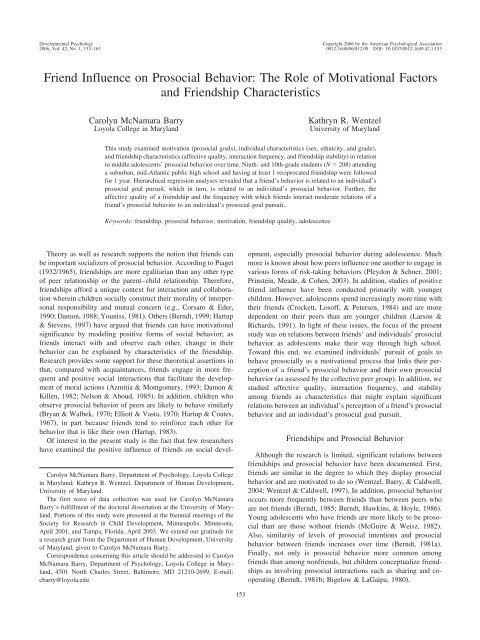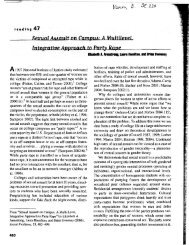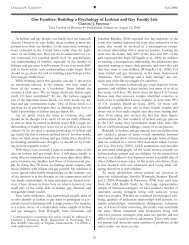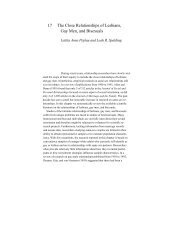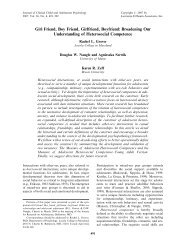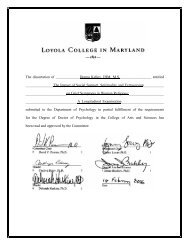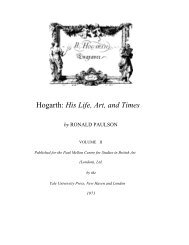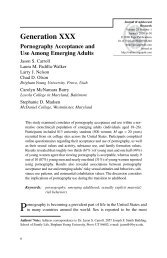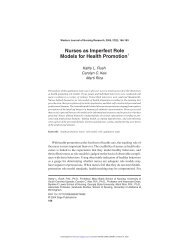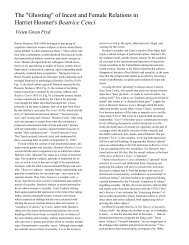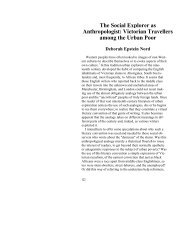Friend Influence on Prosocial Behavior: The Role of Motivational ...
Friend Influence on Prosocial Behavior: The Role of Motivational ...
Friend Influence on Prosocial Behavior: The Role of Motivational ...
Create successful ePaper yourself
Turn your PDF publications into a flip-book with our unique Google optimized e-Paper software.
Developmental Psychology Copyright 2006 by the American Psychological Associati<strong>on</strong><br />
2006, Vol. 42, No. 1, 153–163 0012-1649/06/$12.00 DOI: 10.1037/0012-1649.42.1.153<br />
<str<strong>on</strong>g>Friend</str<strong>on</strong>g> <str<strong>on</strong>g>Influence</str<strong>on</strong>g> <strong>on</strong> <strong>Prosocial</strong> <strong>Behavior</strong>: <strong>The</strong> <strong>Role</strong> <strong>of</strong> Motivati<strong>on</strong>al Factors<br />
and <str<strong>on</strong>g>Friend</str<strong>on</strong>g>ship Characteristics<br />
Carolyn McNamara Barry<br />
Loyola College in Maryland<br />
Kathryn R. Wentzel<br />
University <strong>of</strong> Maryland<br />
This study examined motivati<strong>on</strong> (prosocial goals), individual characteristics (sex, ethnicity, and grade),<br />
and friendship characteristics (affective quality, interacti<strong>on</strong> frequency, and friendship stability) in relati<strong>on</strong><br />
to middle adolescents’ prosocial behavior over time. Ninth- and 10th-grade students (N 208) attending<br />
a suburban, mid-Atlantic public high school and having at least 1 reciprocated friendship were followed<br />
for 1 year. Hierarchical regressi<strong>on</strong> analyses revealed that a friend’s behavior is related to an individual’s<br />
prosocial goal pursuit, which in turn, is related to an individual’s prosocial behavior. Further, the<br />
affective quality <strong>of</strong> a friendship and the frequency with which friends interact moderate relati<strong>on</strong>s <strong>of</strong> a<br />
friend’s prosocial behavior to an individual’s prosocial goal pursuit.<br />
Keywords: friendship, prosocial behavior, motivati<strong>on</strong>, friendship quality, adolescence<br />
<strong>The</strong>ory as well as research supports the noti<strong>on</strong> that friends can<br />
be important socializers <strong>of</strong> prosocial behavior. According to Piaget<br />
(1932/1965), friendships are more egalitarian than any other type<br />
<strong>of</strong> peer relati<strong>on</strong>ship or the parent–child relati<strong>on</strong>ship. <strong>The</strong>refore,<br />
friendships afford a unique c<strong>on</strong>text for interacti<strong>on</strong> and collaborati<strong>on</strong><br />
wherein children socially c<strong>on</strong>struct their morality <strong>of</strong> interpers<strong>on</strong>al<br />
resp<strong>on</strong>sibility and mutual c<strong>on</strong>cern (e.g., Corsaro & Eder,<br />
1990; Dam<strong>on</strong>, 1988; Youniss, 1981). Others (Berndt, 1999; Hartup<br />
& Stevens, 1997) have argued that friends can have motivati<strong>on</strong>al<br />
significance by modeling positive forms <strong>of</strong> social behavior; as<br />
friends interact with and observe each other, change in their<br />
behavior can be explained by characteristics <strong>of</strong> the friendship.<br />
Research provides some support for these theoretical asserti<strong>on</strong>s in<br />
that, compared with acquaintances, friends engage in more frequent<br />
and positive social interacti<strong>on</strong>s that facilitate the development<br />
<strong>of</strong> moral acti<strong>on</strong>s (Azmitia & M<strong>on</strong>tgomery, 1993; Dam<strong>on</strong> &<br />
Killen, 1982; Nels<strong>on</strong> & Aboud, 1985). In additi<strong>on</strong>, children who<br />
observe prosocial behavior <strong>of</strong> peers are likely to behave similarly<br />
(Bryan & Walbek, 1970; Elliott & Vasta, 1970; Hartup & Coates,<br />
1967), in part because friends tend to reinforce each other for<br />
behavior that is like their own (Hartup, 1983).<br />
Of interest in the present study is the fact that few researchers<br />
have examined the positive influence <strong>of</strong> friends <strong>on</strong> social devel-<br />
Carolyn McNamara Barry, Department <strong>of</strong> Psychology, Loyola College<br />
in Maryland; Kathryn R. Wentzel, Department <strong>of</strong> Human Development,<br />
University <strong>of</strong> Maryland.<br />
<strong>The</strong> first wave <strong>of</strong> data collecti<strong>on</strong> was used for Carolyn McNamara<br />
Barry’s fulfillment <strong>of</strong> the doctoral dissertati<strong>on</strong> at the University <strong>of</strong> Maryland.<br />
Porti<strong>on</strong>s <strong>of</strong> this study were presented at the biennial meetings <strong>of</strong> the<br />
Society for Research in Child Development, Minneapolis, Minnesota,<br />
April 2001, and Tampa, Florida, April 2003. We extend our gratitude for<br />
a research grant from the Department <strong>of</strong> Human Development, University<br />
<strong>of</strong> Maryland, given to Carolyn McNamara Barry.<br />
Corresp<strong>on</strong>dence c<strong>on</strong>cerning this article should be addressed to Carolyn<br />
McNamara Barry, Department <strong>of</strong> Psychology, Loyola College in Maryland,<br />
4501 North Charles Street, Baltimore, MD 21210-2699. E-mail:<br />
cbarry@loyola.edu<br />
153<br />
opment, especially prosocial behavior during adolescence. Much<br />
more is known about how peers influence <strong>on</strong>e another to engage in<br />
various forms <strong>of</strong> risk-taking behaviors (Pleyd<strong>on</strong> & Schner, 2001;<br />
Prinstein, Meade, & Cohen, 2003). In additi<strong>on</strong>, studies <strong>of</strong> positive<br />
friend influence have been c<strong>on</strong>ducted primarily with younger<br />
children. However, adolescents spend increasingly more time with<br />
their friends (Crockett, Los<strong>of</strong>f, & Petersen, 1984) and are more<br />
dependent <strong>on</strong> their peers than are younger children (Lars<strong>on</strong> &<br />
Richards, 1991). In light <strong>of</strong> these issues, the focus <strong>of</strong> the present<br />
study was <strong>on</strong> relati<strong>on</strong>s between friends’ and individuals’ prosocial<br />
behavior as adolescents make their way through high school.<br />
Toward this end, we examined individuals’ pursuit <strong>of</strong> goals to<br />
behave prosocially as a motivati<strong>on</strong>al process that links their percepti<strong>on</strong><br />
<strong>of</strong> a friend’s prosocial behavior and their own prosocial<br />
behavior (as assessed by the collective peer group). In additi<strong>on</strong>, we<br />
studied affective quality, interacti<strong>on</strong> frequency, and stability<br />
am<strong>on</strong>g friends as characteristics that might explain significant<br />
relati<strong>on</strong>s between an individual’s percepti<strong>on</strong> <strong>of</strong> a friend’s prosocial<br />
behavior and an individual’s prosocial goal pursuit.<br />
<str<strong>on</strong>g>Friend</str<strong>on</strong>g>ships and <strong>Prosocial</strong> <strong>Behavior</strong><br />
Although the research is limited, significant relati<strong>on</strong>s between<br />
friendships and prosocial behavior have been documented. First,<br />
friends are similar in the degree to which they display prosocial<br />
behavior and are motivated to do so (Wentzel, Barry, & Caldwell,<br />
2004; Wentzel & Caldwell, 1997). In additi<strong>on</strong>, prosocial behavior<br />
occurs more frequently between friends than between peers who<br />
are not friends (Berndt, 1985; Berndt, Hawkins, & Hoyle, 1986).<br />
Young adolescents who have friends are more likely to be prosocial<br />
than are those without friends (McGuire & Weisz, 1982).<br />
Also, similarity <strong>of</strong> levels <strong>of</strong> prosocial intenti<strong>on</strong>s and prosocial<br />
behavior between friends increases over time (Berndt, 1981a).<br />
Finally, not <strong>on</strong>ly is prosocial behavior more comm<strong>on</strong> am<strong>on</strong>g<br />
friends than am<strong>on</strong>g n<strong>on</strong>friends, but children c<strong>on</strong>ceptualize friendships<br />
as involving prosocial interacti<strong>on</strong>s such as sharing and cooperating<br />
(Berndt, 1981b; Bigelow & LaGaipa, 1980).
154<br />
It is likely that these significant relati<strong>on</strong>s partly reflect the fact<br />
that adolescents who dem<strong>on</strong>strate <strong>on</strong>e type <strong>of</strong> social competence<br />
(i.e., making friends) <strong>of</strong>ten display other types as well. Of additi<strong>on</strong>al<br />
interest, however, is whether these relati<strong>on</strong>s also reflect a<br />
process <strong>of</strong> friend influence (Berndt, 1999; Hartup, 1996). As noted<br />
by Hartup and Stevens (1997), theoretical models to explain the<br />
process <strong>of</strong> friend influence are scant. However, some scholars<br />
(e.g., Berndt, 1999; Wentzel et al., 2004) have adopted a sociallearning<br />
perspective to explain this process. For instance, individuals<br />
might develop specific behavioral styles or interests because<br />
these are c<strong>on</strong>sidered to be desirable characteristics <strong>of</strong> their close<br />
friends (Bukowski & Hoza, 1989; Hartup, 1996; Hartup &<br />
Stevens, 1997). Specifically, the tenets <strong>of</strong> observati<strong>on</strong>al learning<br />
(e.g., Bandura, 1986) support the noti<strong>on</strong> that if a friend models<br />
certain types <strong>of</strong> behavior, an individual is likely to behave like the<br />
friend subsequently, because exposure to modeled behavior is<br />
frequent and affectively charged.<br />
Adolescents report greater frequency in observing their friends’<br />
behavior than their n<strong>on</strong>friends’ behavior (Crockett et al., 1984).<br />
Moreover, friendships typically are characterized by str<strong>on</strong>g emoti<strong>on</strong>al<br />
b<strong>on</strong>ds, thereby increasing the likelihood that friends will<br />
imitate each other’s behavior (Berndt & Perry, 1986). Given the<br />
str<strong>on</strong>g emoti<strong>on</strong>al b<strong>on</strong>ds between friends (Berndt & Perry, 1986),<br />
especially during adolescence, it is plausible that friends might<br />
mimic each other’s behavior. <strong>The</strong>refore, friend influence by way<br />
<strong>of</strong> observati<strong>on</strong>al learning is most likely to occur when (a) the<br />
affective quality <strong>of</strong> a friendship is high, such that a friend provides<br />
an important source <strong>of</strong> nurturance to the individual, and (b) the<br />
interacti<strong>on</strong> frequency and friendship stability between an individual<br />
and a friend is high, such that they spend a significant amount<br />
<strong>of</strong> time together.<br />
Bandura (1986) further argued that although behavior can be<br />
learned by observing others, it is likely to be enacted to the extent<br />
that an individual is motivated to do so. <strong>The</strong>refore, an individual’s<br />
behavior might become more similar to a friend’s behavior because<br />
<strong>of</strong> a change in underlying motivati<strong>on</strong>al processes, such as<br />
goals and values. In the current study, therefore, we predicted that<br />
the affective quality, interacti<strong>on</strong> frequency, and stability <strong>of</strong> a<br />
friendship would moderate the relati<strong>on</strong> between a friend’s prosocial<br />
behavior and an individual’s goal pursuit. In turn, an individual’s<br />
prosocial goal pursuit was predicted to relate to an individual’s<br />
prosocial behavior, thereby providing a pathway between<br />
friends’ and individuals’ prosocial behavior. A prosocial goal was<br />
defined as a cognitive representati<strong>on</strong> <strong>of</strong> the extent to which an<br />
individual would like to display prosocial behavior in a given<br />
situati<strong>on</strong> (Ford, 1992; Wentzel, 1994); goal pursuit marks the<br />
frequency with which individuals see themselves as trying to<br />
achieve the goal. Pers<strong>on</strong>al goals are <strong>on</strong>e comp<strong>on</strong>ent <strong>of</strong> a larger<br />
system <strong>of</strong> motivati<strong>on</strong> that includes the directi<strong>on</strong> (pers<strong>on</strong>al goals),<br />
energizati<strong>on</strong> (emoti<strong>on</strong>al arousal), and regulati<strong>on</strong> (pers<strong>on</strong>al agency)<br />
<strong>of</strong> behavior (see Eccles, Wigfield, & Schiefele, 1998; Ford, 1992).<br />
In summary, although the similarity <strong>of</strong> friends’ behavior has<br />
been noted for some time (Kandel, 1978a, 1978b), the process by<br />
which friends influence <strong>on</strong>e another is less well understood. In the<br />
current study, we examined how friendship stability and the affective<br />
quality and interacti<strong>on</strong> frequency between friends increased<br />
the likelihood that a friend’s prosocial behavior would motivate an<br />
individual to behave prosocially. In turn, motivati<strong>on</strong> to behave<br />
prosocially was posited to be related directly to displays <strong>of</strong> proso-<br />
BARRY AND WENTZEL<br />
cial behavior (e.g., Wentzel, 1994), as shown in Figure 1. According<br />
to Kandel (1978a), the similar behavior exhibited by friends is<br />
likely the result <strong>of</strong> two distinct processes: selecti<strong>on</strong> and influence.<br />
Similarity am<strong>on</strong>g friends explains, in part, why individuals become<br />
friends (Hallinan & Williams, 1990); however, friends’<br />
characteristics explain change in adolescents’ behavior over time<br />
(Berndt & Keefe, 1995). Research designs typically have c<strong>on</strong>founded<br />
selecti<strong>on</strong> with influence by not accounting for the extent<br />
to which two friends are similar at the point <strong>of</strong> friendship formati<strong>on</strong>.<br />
<strong>The</strong>refore, to study influence, <strong>on</strong>e must c<strong>on</strong>trol for selecti<strong>on</strong>.<br />
In the current l<strong>on</strong>gitudinal study, we did this by examining the<br />
extent to which friends’ behavior at Time 1 predicted individuals’<br />
behavior at Time 2 while taking into account individuals’ behavior<br />
at Time 1.<br />
Research Questi<strong>on</strong>s<br />
In the current study, we examined the processes by which a<br />
friend’s prosocial behavior is related to change in an individual’s<br />
prosocial behavior over 1 year. Two specific questi<strong>on</strong>s were<br />
addressed:<br />
1. Does prosocial goal pursuit provide a pathway that links a<br />
friend’s prosocial behavior and an individual’s (i.e., target’s)<br />
prosocial behavior? Target’s prosocial goal pursuit was believed to<br />
explain the associati<strong>on</strong> between a friend’s prosocial behavior at<br />
Time 1 and change in target’s prosocial behavior over 1 year.<br />
2. To what extent do friendship characteristics <strong>of</strong> affective<br />
quality, interacti<strong>on</strong> frequency, and friendship stability moderate<br />
the relati<strong>on</strong> <strong>of</strong> a friend’s prosocial behavior to an individual’s<br />
prosocial goal pursuit? <strong>The</strong>se relati<strong>on</strong>s (depicted in Figure 1) were<br />
examined while taking into account sex, grade, and ethnicity;<br />
research has documented that prosocial behavior varies as a functi<strong>on</strong><br />
<strong>of</strong> these variables (Carlo, Hausmann, Christiansen, & Randall,<br />
2003; Eisenberg & Fabes, 1998; Fabes & Eisenberg, 1996 [as cited<br />
in Fabes, Carlo, Kupan<strong>of</strong>f, & Laible, 1999]).<br />
Participants<br />
Method<br />
Students attending a suburban public high school in the New York<br />
metropolitan area participated in the 2-year l<strong>on</strong>gitudinal study. <strong>The</strong> median<br />
annual household incomes for the two towns that comprised the high<br />
school student populati<strong>on</strong> were $106,208 and $101,991 (U.S. Bureau <strong>of</strong> the<br />
Census, 2000). <strong>The</strong> Time 1 sample c<strong>on</strong>sisted <strong>of</strong> 287 9th-grade (n 145)<br />
and 10th-grade (n 142) students, and the l<strong>on</strong>gitudinal sample c<strong>on</strong>sisted<br />
<strong>of</strong> 265 9th-grade (n 134) and 10th-grade (n 131) students. Data were<br />
collected in the spring <strong>of</strong> each c<strong>on</strong>secutive year. All students participated<br />
unless parental permissi<strong>on</strong> was denied (n 26), the students were absent<br />
Figure 1. Proposed c<strong>on</strong>ceptual model <strong>of</strong> friend influence.
<strong>on</strong> the day <strong>of</strong> data collecti<strong>on</strong> (n 24), or the students themselves chose not<br />
to participate <strong>on</strong> the day <strong>of</strong> data collecti<strong>on</strong> (n 1). At both time points, the<br />
demographic characteristics <strong>of</strong> the sample were as follows: 58% female,<br />
42% male, 90% Caucasian, 6% Asian, 2% Hispanic, and 1% members <strong>of</strong><br />
other minority groups. Students who did not participate in the sec<strong>on</strong>d data<br />
collecti<strong>on</strong> because <strong>of</strong> attriti<strong>on</strong> or absence (n 21) did not differ significantly<br />
from those in the l<strong>on</strong>gitudinal sample with respect to demographic<br />
characteristics or study variables.<br />
Procedure<br />
At each <strong>of</strong> the two data collecti<strong>on</strong>s, C.M.B. collected data from all<br />
participating 9th-grade and 10th-grade students in their 43-min social<br />
studies classes (18 classes for Time 1, 17 classes for Time 2) in the spring<br />
<strong>of</strong> each year. Data collecti<strong>on</strong> that occurs later in the school year is<br />
advantageous, because students’ familiarity with their peers is maximized.<br />
Students were assured c<strong>on</strong>fidentiality for all resp<strong>on</strong>ses and informed that<br />
they did not have to answer any questi<strong>on</strong> that they did not want to answer.<br />
<strong>The</strong> researcher remained in the classroom and clarified instructi<strong>on</strong>s as<br />
needed. Classroom teachers (N 6 at Time 1 and Time 2) remained in the<br />
classroom throughout the data collecti<strong>on</strong>.<br />
Measures<br />
All measures were administered at both time points.<br />
Background informati<strong>on</strong>. Students were asked to complete a demographic<br />
questi<strong>on</strong>naire that specified their sex (0 male, 1 female),<br />
grade level (9 or 10 for Time 1, 10 or 11 for Time 2), and ethnicity (1 <br />
Caucasian, 2 African American, 3 Asian, 4 Hispanic, 5 <br />
American Indian, 6 other).<br />
<str<strong>on</strong>g>Friend</str<strong>on</strong>g>ship. Students were instructed to write the first and last names <strong>of</strong><br />
their three best friends from their high school; however, they were informed<br />
that they could choose fewer names if they so desired. Only same-sex friendships<br />
were investigated in the current study because these capture the majority<br />
<strong>of</strong> best friendships for adolescents (Hartup, 1992), and they differ in quality<br />
from opposite-sex friendships (Sharabany, Gersh<strong>on</strong>i, & H<strong>of</strong>man, 1981). Samegrade<br />
friendships were examined to maximize the interacti<strong>on</strong> frequency in<br />
these school-based relati<strong>on</strong>ships. From the names provided, reciprocated<br />
friendships were determined by matching students’ school-based best friend<br />
nominati<strong>on</strong>s with each other. At Time 1, 21% <strong>of</strong> the students had no reciprocated<br />
friendships, 34% had <strong>on</strong>e reciprocated friendship, 30% had two reciprocated<br />
friendships, and 15% had three reciprocated friendships. At Time 2,<br />
16% <strong>of</strong> the students had no reciprocated friendships, 31% had <strong>on</strong>e reciprocated<br />
friendship, 36% had two reciprocated friendships, and 17% had three reciprocated<br />
friendships. Data from students who had at least <strong>on</strong>e reciprocated<br />
friendship were used in all analyses (n 228, Time 1; n 221, Time 2); cases<br />
in which nominated best friendships were not reciprocated (n 59, Time 1;<br />
n 44, Time 2) were disregarded.<br />
All data corresp<strong>on</strong>ding to a target individual’s reciprocated friends were<br />
obtained from either the sole reciprocated friendship or a randomly selected<br />
reciprocated friend (if the target had more than <strong>on</strong>e). For all analyses, listwise<br />
deleti<strong>on</strong> was used, resulting in a final l<strong>on</strong>gitudinal sample <strong>of</strong> 208. Am<strong>on</strong>g the<br />
original sample <strong>of</strong> ethnic minority students at Time 1, 42% did not have a<br />
reciprocated friendship. Am<strong>on</strong>g ethnic minority students with a reciprocated<br />
friendship, <strong>on</strong>ly 4 (i.e., 29%) had a same-race friendship, and all <strong>of</strong> these were<br />
between Asian Americans. <strong>The</strong> remaining 71% <strong>of</strong> the reciprocated friendships<br />
am<strong>on</strong>g ethnic minorities were cross-race, with most (50%) <strong>of</strong> those friendships<br />
between Asian American and Caucasian students.<br />
Affective quality. Two measures were used to assess affective quality:<br />
friendship closeness and friendship importance. <str<strong>on</strong>g>Friend</str<strong>on</strong>g>ship closeness was<br />
assessed with the Affective B<strong>on</strong>d and Reflected Appraisal subscales <strong>of</strong> the<br />
<str<strong>on</strong>g>Friend</str<strong>on</strong>g>ship Qualities Scale (Bukowski, Hoza, & Boivin, 1994). Students<br />
were asked to indicate how true five statements were about each <strong>of</strong> their<br />
nominated friendships <strong>on</strong> a scale <strong>of</strong> 1 (not true) to5(really true). Because<br />
PROSOCIAL BEHAVIOR<br />
students could nominate up to three friends, three copies <strong>of</strong> this questi<strong>on</strong>naire<br />
were provided to each student. Students were asked to write the name<br />
<strong>of</strong> their respective friend <strong>on</strong> a line labeled <str<strong>on</strong>g>Friend</str<strong>on</strong>g> #1, <str<strong>on</strong>g>Friend</str<strong>on</strong>g> #2, or<str<strong>on</strong>g>Friend</str<strong>on</strong>g><br />
#3; each item referred to <str<strong>on</strong>g>Friend</str<strong>on</strong>g> #1, #2, or #3, respectively. A sample item<br />
from the Affective B<strong>on</strong>d subscale is “I feel happy when I am with <str<strong>on</strong>g>Friend</str<strong>on</strong>g><br />
#1,” and a sample item from the Reflected Appraisal subscale is “When I<br />
do a good job at something, <str<strong>on</strong>g>Friend</str<strong>on</strong>g> #1 is happy for me.” <strong>The</strong> five scores<br />
for each friend were averaged to form a single closeness score; <strong>on</strong>ly Time<br />
1 scores were used for analyses (M 4.00, SD 0.75, Cr<strong>on</strong>bach’s <br />
.85). According to Bukowski et al. (1994), reciprocated friendships have<br />
higher closeness scores than do unreciprocated friendships, and stable<br />
friendships over a 6-m<strong>on</strong>th period have been associated with significantly<br />
higher ( p .05) closeness scores than have unstable friendships.<br />
Affective quality was also assessed by a target individual’s perceived<br />
importance <strong>of</strong> a friendship. After students indicated the names <strong>of</strong> their three<br />
school-based best friends, they were instructed to rate each friendship <strong>on</strong> a<br />
scale <strong>of</strong> 1 (important) to3(extremely important); <strong>on</strong>ly Time 1 scores were<br />
used for analyses (M 2.48, SD 0.65). <strong>The</strong> two indicators <strong>of</strong> affective<br />
quality were related significantly (r .55, p .001), and thus, scores were<br />
averaged to form a composite (M 3.24, SD 0.62).<br />
Interacti<strong>on</strong> frequency. Students completed the Interacti<strong>on</strong> Frequency<br />
subscale <strong>of</strong> Berndt and Keefe’s friendship features questi<strong>on</strong>naire (T. J.<br />
Berndt, pers<strong>on</strong>al communicati<strong>on</strong>, October 1997). Students were asked to<br />
indicate how frequently they interacted with their friend by rating six items<br />
(see the Appendix) <strong>on</strong> a scale <strong>of</strong> 1 (never) to5(every day). (With Berndt’s<br />
permissi<strong>on</strong>, we made a minor modificati<strong>on</strong> to the wording <strong>of</strong> the scale such<br />
that “this friend” was replaced with “<str<strong>on</strong>g>Friend</str<strong>on</strong>g> #1,” “<str<strong>on</strong>g>Friend</str<strong>on</strong>g> #2,” or “<str<strong>on</strong>g>Friend</str<strong>on</strong>g><br />
#3” so as to remind the students <strong>of</strong> the particular friendship about which<br />
they were answering questi<strong>on</strong>s.) <strong>The</strong> six scores for each friend were then<br />
averaged to form a single interacti<strong>on</strong>-frequency score; <strong>on</strong>ly Time 1 scores<br />
were used for analyses (M 3.44, SD 0.70, Cr<strong>on</strong>bach’s .78).<br />
<str<strong>on</strong>g>Friend</str<strong>on</strong>g>ship stability. As noted above, the l<strong>on</strong>gitudinal sample c<strong>on</strong>sisted<br />
<strong>on</strong>ly <strong>of</strong> individuals with a reciprocated friend at Time 1. <str<strong>on</strong>g>Friend</str<strong>on</strong>g>ship-stability<br />
scores reflected whether the target maintained a reciprocated friendship over<br />
time. If target’s reciprocated friendship at Time 1 was also reciprocated at<br />
Time 2, then friendship stability was coded as 3; if target’s reciprocated<br />
friendship at Time 1 was unreciprocated (but menti<strong>on</strong>ed) at Time 2, friendship<br />
stability was coded as 2; if target’s reciprocated friendship at Time 1 was not<br />
menti<strong>on</strong>ed as a friend at Time 2, then friendship stability was coded as 1. On<br />
the basis <strong>of</strong> the sample <strong>of</strong> <strong>on</strong>ly those with reciprocated friendships at Time 1,<br />
the frequencies for friendship stability were as follows: 31.8% for 1, 9.8% for<br />
2, and 58.4% for 3.<br />
<strong>Prosocial</strong> goal pursuit. Students were asked to complete the <strong>Prosocial</strong><br />
Goal Pursuit scale (Wentzel, 1991), which c<strong>on</strong>sists <strong>of</strong> academic (e.g.,<br />
“How <strong>of</strong>ten do you try to share what you’ve learned with your classmates?”)<br />
and social (e.g., “How <strong>of</strong>ten do you try to cheer some<strong>on</strong>e up when<br />
something has g<strong>on</strong>e wr<strong>on</strong>g?”) subscales. Students rated <strong>on</strong> a scale <strong>of</strong> 1<br />
(rarely) to5(almost always) how <strong>of</strong>ten they tried to accomplish various<br />
prosocial behaviors. <strong>The</strong> two subscales were correlated significantly (r <br />
.46, p .001), and thus, scores were averaged to form a composite (M <br />
3.78, SD 0.56, Cr<strong>on</strong>bach’s .75).<br />
Target’s prosocial behavior. Peer nominati<strong>on</strong>s were used to assess<br />
target’s prosocial behavior (see Wentzel, 1994). Students were given three<br />
sheets <strong>of</strong> paper, with a different behavioral descripti<strong>on</strong> <strong>on</strong> each, al<strong>on</strong>g with<br />
a list <strong>of</strong> 15 randomly generated names <strong>of</strong> same-sex students from their<br />
grade. Lists <strong>of</strong> names were randomly generated to obtain independent<br />
nominati<strong>on</strong>s for each behavior, to gain the perspective <strong>of</strong> the peer group at<br />
large, and to minimize the amount <strong>of</strong> time necessary for data collecti<strong>on</strong>.<br />
<strong>The</strong> three questi<strong>on</strong>s were as follows:<br />
1. Who cooperates and shares?<br />
2. Who helps other kids when they have a problem?<br />
3. Who shares things with you when you need something?<br />
155
156<br />
Each student’s name appeared <strong>on</strong> other students’ lists approximately 12<br />
times for each questi<strong>on</strong>. Students were asked to circle the names <strong>of</strong><br />
classmates who fit each behavioral descripti<strong>on</strong> and to cross out all names<br />
<strong>of</strong> classmates whom they did not know. Scoring c<strong>on</strong>sisted <strong>of</strong> computing a<br />
ratio <strong>of</strong> the number <strong>of</strong> nominati<strong>on</strong>s a student received divided by the<br />
number <strong>of</strong> times the student’s name appeared minus the number <strong>of</strong> times<br />
the student was not known by classmates. Because these items were<br />
correlated significantly (for Time 1, r .60 for Questi<strong>on</strong>s 1 and 2, r .62<br />
for Questi<strong>on</strong>s 1 and 3, and r .56 for Questi<strong>on</strong>s 2 and 3; for Time 2, r <br />
.58 for Questi<strong>on</strong>s 1 and 2, r .65 for Questi<strong>on</strong>s 1 and 3, and r .64<br />
for Questi<strong>on</strong>s 2 and 3; for all six correlati<strong>on</strong>s, p .001), the three<br />
nominati<strong>on</strong> scores were averaged to form a prosocial behavior composite<br />
at each time point.<br />
<str<strong>on</strong>g>Friend</str<strong>on</strong>g>’s prosocial behavior. Each participant was asked to complete<br />
the <strong>Prosocial</strong> Interacti<strong>on</strong> scale <strong>of</strong> the questi<strong>on</strong>naire <strong>on</strong> friendship features<br />
(Berndt & Keefe, 1995) and the Help scale <strong>of</strong> the <str<strong>on</strong>g>Friend</str<strong>on</strong>g>ship Qualities<br />
Scale (Bukowski et al., 1994). A sample item for the <strong>Prosocial</strong> Interacti<strong>on</strong><br />
scale is “<str<strong>on</strong>g>Friend</str<strong>on</strong>g> #1 helps me if I can’t do something by myself.” <strong>The</strong> Help<br />
scale c<strong>on</strong>sists <strong>of</strong> two subscales: Aid (e.g., “<str<strong>on</strong>g>Friend</str<strong>on</strong>g> #1 would help me when<br />
I needed it”) and Protecti<strong>on</strong> (e.g., “<str<strong>on</strong>g>Friend</str<strong>on</strong>g> #1 would stick up for me if<br />
another kid was causing me trouble”). <strong>The</strong> original scales have two<br />
different rating systems; to keep the directi<strong>on</strong>s as clear and simple as<br />
possible for the participants, we adopted the Bukowski et al. (1994) rating<br />
system. Thus, students were asked to rate <strong>on</strong> a scale <strong>of</strong> 1 (not true) to5<br />
(really true) how <strong>of</strong>ten the specified friend exhibits various indicators <strong>of</strong><br />
prosocial behavior. Each participant was asked to resp<strong>on</strong>d to these prosocial<br />
items for each nominated friend. <strong>The</strong>n the nine scores for each friend<br />
were averaged to form a single prosocial-behavior score (for Time 1, M <br />
4.04, SD 0.68, Cr<strong>on</strong>bach’s .76; for Time 2, M 4.18, SD 0.76,<br />
Cr<strong>on</strong>bach’s .75).<br />
Results<br />
In this study, we sought to identify the process by which friends’<br />
prosocial behavior relates to targets’ prosocial behavior by addressing<br />
two research questi<strong>on</strong>s. For the first research questi<strong>on</strong>,<br />
goals were posited to provide a pathway between a friend’s prosocial<br />
behavior and changes in a target’s prosocial behavior. Specifically,<br />
we predicted that a friend’s behavior would be related to<br />
changes in goal pursuit over time; in turn, a target individual’s goal<br />
pursuit would be related to that target’s change in prosocial behavior.<br />
To examine this questi<strong>on</strong>, we applied the most stringent<br />
test <strong>of</strong> mediati<strong>on</strong>. As described by Bar<strong>on</strong> and Kenny (1986),<br />
Table 1<br />
Intercorrelati<strong>on</strong>s Am<strong>on</strong>g Variables<br />
support for mediati<strong>on</strong> is found when (a) the independent variable<br />
significantly predicts both the mediator and the outcome (i.e.,<br />
friend’s prosocial behavior significantly predicts both target’s<br />
prosocial goal pursuit and target’s prosocial behavior), (b) the<br />
mediator significantly predicts the outcome (i.e., target’s prosocial<br />
goal pursuit significantly predicts target’s prosocial behavior), and<br />
(c) the independent variable predicts the outcome less (partial<br />
mediati<strong>on</strong>) or n<strong>on</strong>significantly (complete mediati<strong>on</strong>) when the<br />
mediator also is included as a predictor (i.e., friend’s prosocial<br />
behavior is a less significant or n<strong>on</strong>significant predictor <strong>of</strong> target’s<br />
prosocial behavior when target’s prosocial goal pursuit is included<br />
in the regressi<strong>on</strong> equati<strong>on</strong>).<br />
We also examined the role <strong>of</strong> friendship characteristics (affective<br />
quality, interacti<strong>on</strong> frequency) in moderating the relati<strong>on</strong><br />
between friend’s prosocial behavior at Time 1 (T1) and change in<br />
target’s prosocial goal pursuit over time; and we examined the role<br />
<strong>of</strong> friendship stability in moderating the relati<strong>on</strong> between friend’s<br />
prosocial behavior at Time 2 (T2) and change in target’s prosocial<br />
goal pursuit over time (in this case, the T2 score for friend’s<br />
behavior was used, because friendship stability occurred over two<br />
time points). According to Bar<strong>on</strong> and Kenny (1986), support for<br />
moderati<strong>on</strong> is found when interacti<strong>on</strong> terms entered at the final<br />
step <strong>of</strong> a hierarchical regressi<strong>on</strong> are significant. Support for moderati<strong>on</strong><br />
may also be found when an individual interacti<strong>on</strong> term<br />
(e.g., Affective Quality <str<strong>on</strong>g>Friend</str<strong>on</strong>g>’s <strong>Prosocial</strong> <strong>Behavior</strong>) is a significant<br />
predictor, even if the overall step for the interacti<strong>on</strong> term<br />
is not significant. A power analysis was c<strong>on</strong>ducted in accordance<br />
with Cohen (1992), and the final l<strong>on</strong>gitudinal sample size was<br />
found to be adequate to detect medium effect sizes.<br />
Questi<strong>on</strong> 1: Does <strong>Prosocial</strong> Goal Pursuit Provide a<br />
Pathway That Links a <str<strong>on</strong>g>Friend</str<strong>on</strong>g>’s <strong>Prosocial</strong> <strong>Behavior</strong><br />
and an Individual’s <strong>Prosocial</strong> <strong>Behavior</strong>?<br />
Target’s prosocial goal pursuit was predicted to explain the<br />
associati<strong>on</strong> between a friend’s prosocial behavior (T1) and a<br />
target’s prosocial behavior 1 year later, as depicted in Figure 1. To<br />
examine this hypothesis, we first computed zero-order correlati<strong>on</strong>s.<br />
As shown in Table 1, friend’s prosocial behavior was related<br />
significantly and positively to target’s prosocial goal pursuit at<br />
Variable 1 2 3 4 5 6 7 8 9<br />
1. Sex —<br />
2. <str<strong>on</strong>g>Friend</str<strong>on</strong>g>’s prosocial behavior, T1<br />
(target’s percepti<strong>on</strong> <strong>of</strong> behavior) .36*** —<br />
3. Affective quality, T1 .42*** .73*** —<br />
4. Interacti<strong>on</strong> frequency, T1 .15* .39*** .49*** —<br />
5. <str<strong>on</strong>g>Friend</str<strong>on</strong>g>ship stability .03 .06 .19*** .12 —<br />
6. Target’s prosocial goal pursuit, T1 .35*** .34*** .25*** .17** .01 —<br />
7. Target’s prosocial goal pursuit, T2 .35*** .32*** .24*** .09 .00 .59*** —<br />
8. Target’s prosocial behavior, T1<br />
(peer-nominated behavior) .26*** .01 .09 .06 .09 .25*** .18** —<br />
9. Target’s prosocial behavior, T2<br />
(peer-nominated behavior) .43*** .14* .22** .07 .08 .37*** .28*** .75*** —<br />
Note. n 208. T1 Time 1; T2 Time 2.<br />
* p .05. ** p .01. *** p .001.<br />
BARRY AND WENTZEL
oth time points and to target’s prosocial behavior at T2 (<strong>on</strong> the<br />
basis <strong>of</strong> peer nominati<strong>on</strong>s) but not to target’s prosocial behavior at<br />
T1 (also <strong>on</strong> the basis <strong>of</strong> peer nominati<strong>on</strong>s). Moreover, target’s<br />
prosocial goal pursuit at both time points was related significantly<br />
and positively to target’s prosocial behavior at both time points.<br />
Sex was related significantly and positively to friend’s prosocial<br />
behavior, target’s prosocial goal pursuit (T1 and T2), and target’s<br />
prosocial behavior (T1 and T2). In other words, girls were more<br />
likely to perceive their friends as prosocial, to report frequent<br />
prosocial goal pursuit, and to be nominated by same-sex, samegrade<br />
classmates as more prosocial than were boys. 1<br />
<strong>The</strong> significant correlati<strong>on</strong>s indicated that testing for mediati<strong>on</strong><br />
had merit, in that variables <strong>of</strong> interest were related in the expected<br />
directi<strong>on</strong>s. To test for mediati<strong>on</strong> more formally, we next examined<br />
the pathway from friend’s prosocial behavior to target’s prosocial<br />
goal pursuit with a series <strong>of</strong> regressi<strong>on</strong> models. First, we regressed<br />
prosocial goal pursuit at T1 <strong>on</strong> friend’s prosocial behavior (C<strong>on</strong>diti<strong>on</strong><br />
a <strong>of</strong> Bar<strong>on</strong> & Kenny, 1986). As shown in Table 2, friend’s<br />
prosocial behavior significantly and positively predicted target’s<br />
prosocial goal pursuit, F(2, 174) 16.35, p .0001. (Step 3 was<br />
included to test moderati<strong>on</strong>, which is described in the next secti<strong>on</strong>.)<br />
We next examined relati<strong>on</strong>s between friend’s prosocial behavior<br />
and change in goal pursuit over time by regressing prosocial<br />
goal pursuit at T2 <strong>on</strong> friend’s prosocial behavior at T1, after<br />
c<strong>on</strong>trolling for prosocial goal pursuit at T1 (an extensi<strong>on</strong> <strong>of</strong> Bar<strong>on</strong><br />
& Kenny’s, 1986, C<strong>on</strong>diti<strong>on</strong> a). As shown in Table 3, friend’s<br />
prosocial behavior was not a significant predictor <strong>of</strong> target’s prosocial<br />
goal pursuit (T2), although target’s prosocial goal pursuit (T1)<br />
significantly predicted target’s prosocial goal pursuit (T2). Finally,<br />
we regressed prosocial behavior at T2 <strong>on</strong> both friend’s prosocial<br />
behavior at T1 and prosocial goal pursuit at T2 (C<strong>on</strong>diti<strong>on</strong>s b and<br />
c <strong>of</strong> Bar<strong>on</strong> & Kenny, 1986), after c<strong>on</strong>trolling for prosocial goal<br />
pursuit at T1. As shown in Table 4, target’s prosocial goal pursuit<br />
(T1, but not T2) predicted target’s prosocial behavior at T2 with<br />
friend’s prosocial behavior at T1 c<strong>on</strong>trolled for.<br />
Taken together, the results <strong>of</strong> the regressi<strong>on</strong> analyses indicate<br />
that target’s prosocial goal pursuit (T1) served as a pathway that<br />
links friend’s prosocial behavior (T1; <strong>on</strong> the basis <strong>of</strong> target’s<br />
percepti<strong>on</strong>) to target’s prosocial behavior (T2; <strong>on</strong> the basis <strong>of</strong> peer<br />
nominati<strong>on</strong>s), in that friend’s prosocial behavior (T1) was related<br />
to target’s prosocial goal pursuit (T1), and target’s prosocial goal<br />
Table 2<br />
Results <strong>of</strong> Hierarchical Regressi<strong>on</strong> Analysis <strong>on</strong> Target’s<br />
<strong>Prosocial</strong> Goal Pursuit, Time 1<br />
Variable Step 1 Step 2 Step 3 <br />
1. Sex<br />
2. <str<strong>on</strong>g>Friend</str<strong>on</strong>g>’s prosocial behavior<br />
.30*** .20** .19**<br />
(FPB), T1 .28*** .35***<br />
3. Interacti<strong>on</strong> Frequency FPB, T1 .16*<br />
Affective Quality FPB, T1 .21**<br />
<str<strong>on</strong>g>Friend</str<strong>on</strong>g>ship Stability FPB, T2 .01<br />
R 2<br />
.09*** .07*** .05*<br />
Total R 2<br />
.21***<br />
Note. n 177. <strong>The</strong> standard errors for each step are as follows: .55 (Step<br />
1), .53 (Step 2), and .52 (Step 3). T1 Time 1; T2 Time 2.<br />
* p .05. ** p .01. *** p .001.<br />
PROSOCIAL BEHAVIOR<br />
pursuit at T1 was related to the change in target’s prosocial<br />
behavior over time. However, complete mediati<strong>on</strong>, as defined by<br />
Bar<strong>on</strong> and Kenny (1986), was not supported given that friend’s<br />
prosocial behavior (T1) was a n<strong>on</strong>significant predictor <strong>of</strong> change<br />
in target’s prosocial goal pursuit, and target’s prosocial goal pursuit<br />
(T2) was a n<strong>on</strong>significant predictor <strong>of</strong> target’s prosocial behavior<br />
(T2).<br />
Questi<strong>on</strong> 2: How Do <str<strong>on</strong>g>Friend</str<strong>on</strong>g>ship Characteristics <strong>of</strong><br />
Affective Quality, Interacti<strong>on</strong> Frequency, and <str<strong>on</strong>g>Friend</str<strong>on</strong>g>ship<br />
Stability Moderate the Relati<strong>on</strong> <strong>of</strong> a <str<strong>on</strong>g>Friend</str<strong>on</strong>g>’s <strong>Prosocial</strong><br />
<strong>Behavior</strong> to a Target Individual’s <strong>Prosocial</strong> Goals?<br />
157<br />
In keeping with social-learning theory (Bandura, 1986), we<br />
hypothesized that behavior is learned, in part, through observing<br />
best friends. Moreover, we predicted that friend influence is most<br />
likely to occur by way <strong>of</strong> goal pursuit when (a) the affective<br />
quality <strong>of</strong> a friendship is high, and (b) the interacti<strong>on</strong> frequency<br />
and friendship stability between an individual and a friend are high<br />
such that the individual and friend spend a significant amount <strong>of</strong><br />
time together.<br />
To test for these moderating effects, we included interacti<strong>on</strong><br />
terms at the last step <strong>of</strong> the regressi<strong>on</strong> analyses presented in Tables<br />
2 and 3: Affective Quality <str<strong>on</strong>g>Friend</str<strong>on</strong>g>’s <strong>Prosocial</strong> <strong>Behavior</strong>, Interacti<strong>on</strong><br />
Frequency <str<strong>on</strong>g>Friend</str<strong>on</strong>g>’s <strong>Prosocial</strong> <strong>Behavior</strong>, and <str<strong>on</strong>g>Friend</str<strong>on</strong>g>ship<br />
Stability <str<strong>on</strong>g>Friend</str<strong>on</strong>g>’s <strong>Prosocial</strong> <strong>Behavior</strong>. Affective quality, interacti<strong>on</strong><br />
frequency, and friend’s prosocial behavior were mean centered<br />
to reduce the redundancy <strong>of</strong> each interacti<strong>on</strong> term.<br />
As shown in Table 2, two interacti<strong>on</strong> terms (involving affective<br />
quality and interacti<strong>on</strong> frequency) included at Step 3 significantly<br />
predicted target’s prosocial goal pursuit at T1; however, friendship<br />
stability was not a significant predictor. As shown in Table 3, the<br />
Affective Quality <str<strong>on</strong>g>Friend</str<strong>on</strong>g>’s <strong>Prosocial</strong> <strong>Behavior</strong> interacti<strong>on</strong> term<br />
was not a significant predictor <strong>of</strong> T2 goal pursuit with T1 goal<br />
pursuit c<strong>on</strong>trolled for. (We tested models in which each interacti<strong>on</strong><br />
term was entered as a separate step, and the results were not<br />
significantly different from those reported in Tables 2 and 3).<br />
To explore further the significant Affective Quality <str<strong>on</strong>g>Friend</str<strong>on</strong>g>’s<br />
<strong>Prosocial</strong> <strong>Behavior</strong> interacti<strong>on</strong> for target’s prosocial goal pursuit at<br />
T1, we regressed goal pursuit (T1) <strong>on</strong> friend’s prosocial behavior<br />
for each <strong>of</strong> three levels <strong>of</strong> affective quality, as determined by a<br />
subdivisi<strong>on</strong> <strong>of</strong> the affective quality variable al<strong>on</strong>g the 33rd and<br />
67th percentiles (see Aiken & West, 1991). <str<strong>on</strong>g>Friend</str<strong>on</strong>g>’s behavior was<br />
a significant, positive predictor ( .38, p .001) <strong>of</strong> goal pursuit<br />
at T1 <strong>on</strong>ly when affective quality was high, F(1, 68) 11.43,<br />
SE 0.43, p .001 (see Figure 2). <strong>The</strong>se findings thereby suggest<br />
that friend’s prosocial behavior is related to target’s prosocial goal<br />
pursuit at T1 when the target perceives the friendship to have high<br />
levels <strong>of</strong> affective quality.<br />
To explore further the significant Interacti<strong>on</strong> Frequency <br />
<str<strong>on</strong>g>Friend</str<strong>on</strong>g>’s <strong>Prosocial</strong> <strong>Behavior</strong> interacti<strong>on</strong> for target’s prosocial goal<br />
pursuit at T1, we regressed goal pursuit (T1) <strong>on</strong> friend’s prosocial<br />
behavior for each <strong>of</strong> three levels <strong>of</strong> interacti<strong>on</strong> frequency, as<br />
determined by a subdivisi<strong>on</strong> <strong>of</strong> the interacti<strong>on</strong> frequency variable<br />
1 Initially, grade and ethnicity were included within the first step for all<br />
three regressi<strong>on</strong>s; however, the two variables were n<strong>on</strong>significant and,<br />
thus, omitted from what is reported here.
158<br />
Table 3<br />
Results <strong>of</strong> Hierarchical Regressi<strong>on</strong> Analysis <strong>on</strong> Target’s <strong>Prosocial</strong> Goal Pursuit, Time 2<br />
al<strong>on</strong>g the 33rd and 67th percentiles. <str<strong>on</strong>g>Friend</str<strong>on</strong>g>’s behavior was a<br />
significant, positive predictor ( .42, p .0001) <strong>of</strong> goal pursuit<br />
at T1 <strong>on</strong>ly when interacti<strong>on</strong> frequency was low, F(1, 76) 16.67,<br />
SE 0.57, p .0001 (see Figure 3). Thus, friend’s prosocial<br />
behavior was related to target’s prosocial goal pursuit at T1 when<br />
the target had low levels <strong>of</strong> interacti<strong>on</strong> frequency with the friend.<br />
Finally, as shown in Table 3, Interacti<strong>on</strong> Frequency <str<strong>on</strong>g>Friend</str<strong>on</strong>g>’s<br />
<strong>Prosocial</strong> <strong>Behavior</strong> was a significant, positive predictor <strong>of</strong> change<br />
in target’s prosocial goal pursuit over time. Because the latter<br />
interacti<strong>on</strong> term was positive, in c<strong>on</strong>trast to the negative interacti<strong>on</strong><br />
term shown in Table 2, a close examinati<strong>on</strong> through follow-up<br />
analyses is required to understand such significant results, because<br />
inspecti<strong>on</strong> <strong>of</strong> the sign <strong>of</strong> the interacti<strong>on</strong> term can be misleading<br />
(Mossholder, Kemery, & Bedeian, 1990). As a result, we further<br />
explored this finding, in accordance with Aiken and West (1991),<br />
by regressing target’s goal pursuit (T2) <strong>on</strong> both goal pursuit (T1)<br />
and friend’s prosocial behavior for each <strong>of</strong> the three levels <strong>of</strong><br />
interacti<strong>on</strong> frequency. <str<strong>on</strong>g>Friend</str<strong>on</strong>g>’s behavior was a significant, positive<br />
predictor ( .29, p .002) <strong>of</strong> goal pursuit at T2 <strong>on</strong>ly when<br />
interacti<strong>on</strong> frequency was high, F(2, 72) 30.97, SE 0.41, p <br />
.0001 (see Figure 4). <strong>The</strong>refore, low frequency <strong>of</strong> interacti<strong>on</strong><br />
appeared to have a significant and positive impact <strong>on</strong> c<strong>on</strong>current<br />
Variable Step 1 Step 2 Step 3 Step 4 <br />
1. Sex .32*** .15* .11† .11†<br />
2. <strong>Prosocial</strong> Goal Pursuit, T1 .57*** .54*** .57***<br />
3. <str<strong>on</strong>g>Friend</str<strong>on</strong>g>’s prosocial behavior (FPB), T1 .12† .05<br />
4. Interacti<strong>on</strong> Frequency FPB, T1 .13*<br />
Affective Quality FPB, T1 .06<br />
<str<strong>on</strong>g>Friend</str<strong>on</strong>g>ship Stability FPB, T2 .09<br />
R 2<br />
.10*** .30*** .01† .02<br />
Total R 2<br />
.43***<br />
Note. n 177. <strong>The</strong> standard errors for each step are as follows: .57 (Step 1), .47 (Step 2), .46 (Step 3), and<br />
.46 (Step 4). T1 Time 1; T2 Time 2.<br />
† p .10. * p .05. *** p .001.<br />
Table 4<br />
Results <strong>of</strong> Hierarchical Regressi<strong>on</strong> Analysis <strong>on</strong> Target’s<br />
<strong>Prosocial</strong> <strong>Behavior</strong>, Time 2<br />
Variable Step 1 Step 2 Step 3 Step 4 <br />
1. Sex .43*** .21*** .20*** .20***<br />
2. Target’s prosocial<br />
behavior, T1<br />
.65*** .66*** .66***<br />
Target’s prosocial goal<br />
pursuit, T1<br />
.14** .12** .13*<br />
3. <str<strong>on</strong>g>Friend</str<strong>on</strong>g>’s prosocial<br />
behavior, T1<br />
.04 .04<br />
4. Target’s prosocial goal<br />
pursuit, T2<br />
.01<br />
R 2<br />
.18*** .45*** .00 .00<br />
Total R 2<br />
.63***<br />
Note. n 206. <strong>The</strong> standard errors for each step are as follows: .16 (Step<br />
1) and .11 (Steps 2, 3, and 4). T1 Time 1; T2 Time 2.<br />
* p .05. ** p .01. *** p .001.<br />
BARRY AND WENTZEL<br />
relati<strong>on</strong>s between friends’ prosocial behavior and targets’ goal<br />
pursuit, whereas high interacti<strong>on</strong> frequency appeared to have a<br />
significant and positive impact <strong>on</strong> relati<strong>on</strong>s between friends’<br />
prosocial behavior and targets’ goal pursuit over time.<br />
Discussi<strong>on</strong><br />
In this study, we examined the process by which a best friend<br />
might influence an individual’s prosocial behavior. As predicted, a<br />
friend’s prosocial behavior (as observed by the target individual)<br />
was related to a target’s prosocial behavior (<strong>on</strong> the basis <strong>of</strong> peer<br />
nominati<strong>on</strong>s) over time by way <strong>of</strong> a target’s pursuit <strong>of</strong> goals to be<br />
prosocial at T1. In additi<strong>on</strong>, friendship characteristics moderated<br />
the relati<strong>on</strong> between a friend’s prosocial behavior and a target’s<br />
goal pursuit such that relati<strong>on</strong>s differed as a functi<strong>on</strong> <strong>of</strong> the<br />
affective quality and frequency <strong>of</strong> interacti<strong>on</strong> between friends.<br />
<strong>The</strong>refore, our findings provide further c<strong>on</strong>firmati<strong>on</strong> that motivati<strong>on</strong>al<br />
processes can explain significant associati<strong>on</strong>s between the<br />
behaviors <strong>of</strong> two friends, highlighting the importance <strong>of</strong> friendship<br />
characteristics in defining the nature <strong>of</strong> relati<strong>on</strong>ships between a<br />
friend’s behavior and an individual’s goal pursuit. Finally, the<br />
significant gender differences in prosocial behavior and prosocial<br />
goal pursuit found in our adolescent sample extend empirical<br />
research (e.g., Parker & Asher, 1993) that has found such differences<br />
in early and middle childhood (e.g., Eisenberg & Mussen,<br />
1989), and they support theoretical c<strong>on</strong>tenti<strong>on</strong>s (see Eisenberg &<br />
Figure 2. Effect <strong>of</strong> Affective Quality <str<strong>on</strong>g>Friend</str<strong>on</strong>g>’s <strong>Prosocial</strong> <strong>Behavior</strong> <strong>on</strong><br />
target’s prosocial goal pursuit at Time 1 (T1).
Figure 3. Effect <strong>of</strong> Interacti<strong>on</strong> Frequency (Int Freq) <str<strong>on</strong>g>Friend</str<strong>on</strong>g>’s <strong>Prosocial</strong><br />
<strong>Behavior</strong> <strong>on</strong> target’s prosocial goal pursuit at Time 1 (T1).<br />
Fabes, 1998) that girls are expected to behave in prosocial ways to<br />
a greater extent than are boys.<br />
<strong>Prosocial</strong> Goal Pursuit as an Intermediary Process<br />
According to the tenets <strong>of</strong> observati<strong>on</strong>al learning (Bandura,<br />
1986), an individual is likely to behave similarly to a friend<br />
because exposure to modeled behavior is frequent and affectively<br />
charged. In additi<strong>on</strong>, Bandura (1986) proposed that although behavior<br />
can be learned by observing others, it is likely to be enacted<br />
to the extent that an individual is motivated to do so. <strong>The</strong> findings<br />
<strong>of</strong> the current study support these noti<strong>on</strong>s, in that an individual’s<br />
pursuit <strong>of</strong> prosocial goals (at both time points) was related to his or<br />
her percepti<strong>on</strong> <strong>of</strong> his or her friend’s prosocial behavior. In additi<strong>on</strong>,<br />
changes in prosocial behavior (observed by the peer group)<br />
over time were related to levels <strong>of</strong> goal pursuit at T1. <strong>The</strong>se results<br />
also replicate previous findings linking the prosocial behavior <strong>of</strong><br />
friends by way <strong>of</strong> goal pursuit (Wentzel et al., 2004), and they<br />
provide further dem<strong>on</strong>strati<strong>on</strong> that friendships can have a significant<br />
influence <strong>on</strong> motivati<strong>on</strong>al processes (e.g., Rose & Asher,<br />
1999). <strong>The</strong> findings also affirm that prosocial goal setting is related<br />
to displays <strong>of</strong> prosocial behavior over the course <strong>of</strong> 1 year (e.g.,<br />
Nels<strong>on</strong> & Crick, 1999; Wentzel et al., 2004).<br />
Our findings indicate that the amount <strong>of</strong> change in an individual’s<br />
goal pursuit explained by a friend’s behavior is fairly small.<br />
Indeed, the prosocial behavior <strong>of</strong> the students in our study was<br />
highly stable over time. This was not surprising given that the<br />
sample was composed <strong>of</strong> adolescents who enjoyed close friendships<br />
and, therefore, were socially competent at the outset. In<br />
additi<strong>on</strong>, given the potential influence <strong>of</strong> adults (e.g., parents,<br />
teachers, relatives), other children (e.g., siblings, rivals), and the<br />
media <strong>on</strong> an adolescent’s behavior, our findings support the noti<strong>on</strong><br />
that a friend’s behavior can be meaningful in the life <strong>of</strong> a student.<br />
It also is important to note, however, that measures <strong>of</strong> a single<br />
best friend’s prosocial behavior also might be a proxy for behavior<br />
displayed by a larger group <strong>of</strong> friends and close acquaintances. For<br />
example, Sage and Kindermann (1999) found that adolescents’<br />
classroom motivati<strong>on</strong> varies as a functi<strong>on</strong> <strong>of</strong> peer-group approval<br />
and disapproval. <strong>The</strong>refore, influence processes within friendship<br />
cliques (see Wentzel & Caldwell, 1997) and peer networks (see<br />
Kindermann, 1993) might be important targets for future research.<br />
PROSOCIAL BEHAVIOR<br />
In additi<strong>on</strong>, an individual might observe and become motivated to<br />
display the behavior <strong>of</strong> peers with whom he or she wants to<br />
become friends. Pairings am<strong>on</strong>g potential or new friends have yet<br />
to be examined in research <strong>on</strong> friend influence. However, research<br />
<strong>on</strong> friendship-making strategies has shown that the display <strong>of</strong><br />
prosocial behavior (e.g., sharing) is a successful strategy for making<br />
friends (Wentzel & Erdley, 1993). <strong>The</strong>refore, changes in<br />
prosocial behavior over time might reflect, in part, changes in<br />
investments in forming and maintaining new friendships.<br />
An unexpected finding was the n<strong>on</strong>significant c<strong>on</strong>current relati<strong>on</strong><br />
between a friend’s and a target’s prosocial behavior at T1<br />
(depicted in Table 1). This lack <strong>of</strong> similarity in friends’ prosocial<br />
behavior has not been reported elsewhere (cf. Wentzel et al.,<br />
2004). A methodological explanati<strong>on</strong> for this finding is that a<br />
friend’s prosocial behavior was established <strong>on</strong> the basis <strong>of</strong> observati<strong>on</strong>s<br />
<strong>of</strong> <strong>on</strong>e individual, whereas a target’s prosocial behavior<br />
was established <strong>on</strong> the basis <strong>of</strong> a larger set <strong>of</strong> peer nominati<strong>on</strong>s.<br />
<strong>The</strong>refore, a friend’s behavior scores reflected a relatively subjective<br />
and less reliable assessment <strong>of</strong> a close friend, whereas a<br />
target’s behavior scores were based <strong>on</strong> a more objective set <strong>of</strong><br />
assessments. In additi<strong>on</strong>, items used to assess a friend’s prosocial<br />
behavior were much more specific, reflecting behavior that is<br />
likely to be observed more frequently by a friend than by the larger<br />
peer group. For these reas<strong>on</strong>s, the lack <strong>of</strong> significant overlap<br />
between these two scores is understandable.<br />
<str<strong>on</strong>g>Friend</str<strong>on</strong>g>ship Characteristics as Moderators<br />
159<br />
<strong>The</strong> results <strong>of</strong> our study also extend work in this area by<br />
documenting the importance <strong>of</strong> friendship characteristics in explaining<br />
relati<strong>on</strong>s between a friend’s behavior and an individual’s<br />
goal pursuit. As suggested by the literature <strong>on</strong> observati<strong>on</strong>al learning,<br />
the affective quality <strong>of</strong> a friendship and the frequency <strong>of</strong><br />
friends’ interacti<strong>on</strong>s, as perceived by an individual, appear to<br />
influence relati<strong>on</strong>s between a friend’s behavior and the individual’s<br />
goal pursuit. However, this influence <strong>on</strong>ly seems to occur<br />
under specific c<strong>on</strong>diti<strong>on</strong>s. For example, findings indicate that a<br />
friend’s prosocial behavior is related positively to an individual’s<br />
goal pursuit <strong>on</strong>ly when the target perceives the affective quality <strong>of</strong><br />
a friendship to be high. In other words, a friend’s prosocial<br />
behavior is most likely to be associated with an individual’s<br />
Figure 4. Effect <strong>of</strong> Interacti<strong>on</strong> Frequency (Int Freq) <str<strong>on</strong>g>Friend</str<strong>on</strong>g>’s <strong>Prosocial</strong><br />
<strong>Behavior</strong> <strong>on</strong> target’s prosocial goal pursuit at Time 2 (T2).
160<br />
motivati<strong>on</strong> to be helpful and cooperative when the individual has<br />
a str<strong>on</strong>g, positive b<strong>on</strong>d with that friend.<br />
Significant moderating effects also were found for the frequency<br />
<strong>of</strong> interacti<strong>on</strong>s between friends. In this case, at T1, a friend’s<br />
observed behavior was related positively to an individual’s goal<br />
pursuit <strong>on</strong>ly when the individual interacted infrequently with the<br />
friend. However, over time, a friend’s prosocial behavior was<br />
related positively to an individual’s goal pursuit when interacti<strong>on</strong><br />
with that friend was frequent. This latter finding would be expected<br />
<strong>on</strong> the basis <strong>of</strong> tenets <strong>of</strong> observati<strong>on</strong>al learning; behavior is<br />
likely to be modeled if an individual has more frequent and stable<br />
exposure to it over time. In c<strong>on</strong>trast, the moderating effect at T1<br />
might suggest that over the short term, modeling effects are not as<br />
str<strong>on</strong>g. One alternative explanati<strong>on</strong> is that individuals who interact<br />
with their best friends infrequently might expend greater effort to<br />
behave prosocially simply to establish and maintain these friendships.<br />
Although suggestive, our findings cannot support causal c<strong>on</strong>clusi<strong>on</strong>s<br />
c<strong>on</strong>cerning the effects <strong>of</strong> friendship qualities <strong>on</strong> an individual’s<br />
prosocial goal pursuit. Indeed, it is possible that these<br />
interacti<strong>on</strong> effects may reflect perceived similarity, such that perceiving<br />
high levels <strong>of</strong> prosocial behavior in a friend to whom <strong>on</strong>e<br />
is emoti<strong>on</strong>ally attached might lead to percepti<strong>on</strong>s <strong>of</strong> <strong>on</strong>e’s self as<br />
behaving in similar ways and, thus, reporting high frequencies <strong>of</strong><br />
goal pursuit. However, some adolescents reported high levels <strong>of</strong><br />
prosocial goal pursuit even when their friends did not display<br />
corresp<strong>on</strong>dingly high levels <strong>of</strong> prosocial behavior (e.g., the high<br />
interacti<strong>on</strong>-frequency group in Figure 3), suggesting that an explanati<strong>on</strong><br />
based <strong>on</strong> similarity <strong>of</strong> friends does not hold for all cases.<br />
Other factors bey<strong>on</strong>d the friendship dyad might also be important<br />
for understanding the link between a friend’s behavior and an<br />
individual’s goal pursuit. For instance, cognitive processes described<br />
by Bandura (1986)—such as how observati<strong>on</strong>s <strong>of</strong> prosocial<br />
behavior are interpreted and stored in memory—and strategy<br />
knowledge c<strong>on</strong>cerning how to actually produce prosocial behavior<br />
might be particularly critical processes to examine in this regard.<br />
Moreover, other motivati<strong>on</strong>al c<strong>on</strong>structs, such as an individual’s<br />
attributi<strong>on</strong>al style (Weiner, 1985) and perceived efficacy for prosocial<br />
behavior (Bandura, 1994), and affective factors such as empathy<br />
(Eisenberg, Wolchik, Goldberg, & Engel, 2002) should be<br />
c<strong>on</strong>sidered to understand more fully the circumstances under<br />
which a target individual’s percepti<strong>on</strong> <strong>of</strong> a friend’s behavior might<br />
influence an individual’s goal pursuit.<br />
Methodological Issues<br />
Several methodological aspects <strong>of</strong> our study also are important<br />
to note. First, our measure <strong>of</strong> friendship placed restricti<strong>on</strong>s <strong>on</strong> who<br />
could be nominated as a friend: same-grade and same-sex individuals<br />
who attended the same public high school. In reality, adolescents<br />
<strong>of</strong>ten have friends who are <strong>of</strong> the opposite sex or are in a<br />
different grade or school than they are. It is important to note,<br />
however, that all <strong>of</strong> the study’s participants, even those without<br />
reciprocated friendships, were able to list at least <strong>on</strong>e best friend<br />
who met our criteria. In additi<strong>on</strong>, a limit <strong>of</strong> three best-friend<br />
nominati<strong>on</strong>s was established. Although it is possible that students<br />
had more than three best friends, it is highly unlikely that a<br />
significant porti<strong>on</strong> <strong>of</strong> students had more than three reciprocated<br />
best friendships (<strong>on</strong>ly 15% <strong>of</strong> the study participants had three<br />
reciprocated best friendships at T1). In general, however, our<br />
BARRY AND WENTZEL<br />
findings must be tempered with the reality that restricti<strong>on</strong>s <strong>on</strong><br />
friendship nominati<strong>on</strong>s might result in identificati<strong>on</strong> <strong>of</strong> reciprocated<br />
friendships that do not represent the best friendships or the<br />
friendships <strong>of</strong> greatest quality for all participants.<br />
In additi<strong>on</strong>, our measure <strong>of</strong> interacti<strong>on</strong> frequency did not include<br />
interacti<strong>on</strong>s that take place via e-mail, instant messaging, text<br />
messaging, or other venues that do not require physical proximity.<br />
Indeed, these forms <strong>of</strong> interacti<strong>on</strong> are becoming increasingly comm<strong>on</strong><br />
am<strong>on</strong>g adolescents (B<strong>on</strong>ebrake, 2002; C<strong>of</strong>fey & Stipp, 1997;<br />
Odell, Korgen, Schumacher, & Delucchi, 2000). As a result, the<br />
extent to which interacti<strong>on</strong> frequency might influence how a<br />
friend’s prosocial behavior is related to an individual’s motivati<strong>on</strong><br />
is likely to be underreported in this study, especially given the high<br />
socioec<strong>on</strong>omic status (SES) <strong>of</strong> the sample and the participants’<br />
likely access to these technologies. Finally, a friend’s prosocial<br />
behavior and a target’s prosocial-behavior scores were assessed <strong>on</strong><br />
the basis <strong>of</strong> informati<strong>on</strong> from the same individual. Although this<br />
practice likely inflated the relati<strong>on</strong> between these two variables,<br />
our model was based <strong>on</strong> the assumpti<strong>on</strong> that an adolescent’s<br />
observati<strong>on</strong>s <strong>of</strong> his or her friend’s behavior (rather than observati<strong>on</strong>s<br />
made by the larger peer group) had the most proximal<br />
influence <strong>on</strong> his or her subsequent behavior.<br />
Sampling issues also are important to note, in that these friendships<br />
occurred in fairly affluent and predominantly European<br />
American communities. <strong>The</strong> prep<strong>on</strong>derance <strong>of</strong> upper-middle-class<br />
European American students in our sample allows for c<strong>on</strong>clusi<strong>on</strong>s<br />
about this populati<strong>on</strong>. However, the current investigati<strong>on</strong> does not<br />
further the understanding <strong>of</strong> friendship influence am<strong>on</strong>g ethnic<br />
minority populati<strong>on</strong>s or students from lower SES communities. A<br />
small literature suggests that friendships differ as a functi<strong>on</strong> <strong>of</strong><br />
ethnicity. For instance, African Americans tend to report denser<br />
networks <strong>of</strong> neighborhood friends but talk to few friends during<br />
school (DuBois & Hirsch, 1990). Moreover, Asian American<br />
adolescents are more likely to have friends <strong>of</strong> the same race than<br />
are both Latino and African American adolescents; however, African<br />
Americans report greater close friendship support than do<br />
Asian Americans (Way & Chen, 2000). <strong>Prosocial</strong> behavior also<br />
varies as a functi<strong>on</strong> <strong>of</strong> ethnicity, such that Mexican American<br />
adolescents tend to prefer cooperative to competitive behaviors<br />
(see Knight, Bernal, & Carlo, 1995) more than do European<br />
Americans. Further, cross-cultural research has documented variati<strong>on</strong>s<br />
in prosocial behavior (for a review, see Carlo, Fabes, Laible,<br />
& Kupan<strong>of</strong>f, 1999). <strong>The</strong>refore, research that uses more ethnically<br />
diverse samples is needed to investigate the generalizability <strong>of</strong> the<br />
influence processes suggested by our findings to other groups <strong>of</strong><br />
n<strong>on</strong>-Caucasian adolescent students.<br />
Although our sample was limited, our findings indicate that<br />
compared with almost 80% <strong>of</strong> European American students who<br />
had reciprocated friendships, <strong>on</strong>ly 58% <strong>of</strong> the ethnic minority<br />
students in the sample had a reciprocated friend. It is possible that<br />
these students were more likely to have friendships outside <strong>of</strong> the<br />
school c<strong>on</strong>text. However, the majority <strong>of</strong> the Asian American<br />
students (the largest ethnic minority group in the school studied)<br />
reported having either a same-race (25%) or cross-race (50%)<br />
friendship (with the remaining 25% reporting no reciprocated<br />
friendship). <strong>The</strong>refore, adolescents in at least <strong>on</strong>e minority group<br />
appeared to be integrated into the social culture <strong>of</strong> the school to a<br />
greater extent than were other ethnic minority adolescents. <strong>The</strong>se<br />
differences in friendship formati<strong>on</strong> as a functi<strong>on</strong> <strong>of</strong> ethnicity
clearly deserve further study, with a focus <strong>on</strong> possible c<strong>on</strong>founding<br />
effects <strong>of</strong> SES <strong>of</strong> individual students, heterogeneity <strong>of</strong> values<br />
within ethnic groups, and the degree to which these groups are a<br />
minority within a particular school. Given that not all adolescents<br />
are able to form friendships <strong>of</strong> high quality, scholars should also<br />
examine influence processes am<strong>on</strong>g adolescents with low levels <strong>of</strong><br />
friendship quality.<br />
C<strong>on</strong>clusi<strong>on</strong><br />
<strong>The</strong> results <strong>of</strong> the present study suggest that the influence <strong>of</strong> best<br />
friends <strong>on</strong> prosocial behavior might be explained, in part, by<br />
observati<strong>on</strong>al learning processes. Specifically, goal pursuit appears<br />
to provide a pathway that links a friend’s prosocial behavior to a<br />
target’s prosocial behavior, with friendship characteristics (i.e.,<br />
affective quality and interacti<strong>on</strong> frequency) determining the nature<br />
<strong>of</strong> relati<strong>on</strong>s between a friend’s prosocial behavior and a target’s<br />
goal pursuit. To date, the body <strong>of</strong> literature <strong>on</strong> friend influence has<br />
focused <strong>on</strong> numerous negative behaviors, such as alcohol (e.g.,<br />
Urberg, Degˇirmenciogˇlu, & Pilgrim, 1997) and cigarette use (e.g.,<br />
Ennett & Bauman, 1994). <strong>The</strong>refore, the current findings also<br />
extend the literature <strong>on</strong> adolescent friend influence to more positive<br />
behaviors. Immediate directi<strong>on</strong>s for future research should<br />
include the examinati<strong>on</strong> <strong>of</strong> individual characteristics (e.g., empathy),<br />
other motivati<strong>on</strong>al c<strong>on</strong>structs, and the roles <strong>of</strong> multiple<br />
friends within an ethnically and socioec<strong>on</strong>omically diverse sample.<br />
<strong>The</strong> study <strong>of</strong> friend influence could also be broadened to include<br />
other peer socializers (e.g., members <strong>of</strong> cliques and peer networks)<br />
to yield more ecological validity in the study <strong>of</strong> how and why<br />
adolescents are motivated to display prosocial behavior.<br />
References<br />
Aiken, L. S., & West, S. G. (1991). Multiple regressi<strong>on</strong>: Testing and<br />
interpreting interacti<strong>on</strong>s. Newbury Park, CA: Sage.<br />
Azmitia, M., & M<strong>on</strong>tgomery, R. (1993). <str<strong>on</strong>g>Friend</str<strong>on</strong>g>ship, transactive dialogues,<br />
and the development <strong>of</strong> scientific reas<strong>on</strong>ing. Social Development, 2,<br />
202–221.<br />
Bandura, A. (1986). Social foundati<strong>on</strong>s <strong>of</strong> thought and acti<strong>on</strong>: A social<br />
cognitive theory. Englewood Cliffs, NJ: Prentice Hall.<br />
Bandura, A. (1994). Self-efficacy: <strong>The</strong> exercise <strong>of</strong> c<strong>on</strong>trol. New York:<br />
Freeman.<br />
Bar<strong>on</strong>, R. M., & Kenny, D. A. (1986). <strong>The</strong> moderator–mediator variable<br />
distincti<strong>on</strong> in social psychological research: C<strong>on</strong>ceptual, strategic, and<br />
statistical c<strong>on</strong>siderati<strong>on</strong>s. Journal <strong>of</strong> Pers<strong>on</strong>ality and Social Psychology,<br />
51, 1173–1182.<br />
Berndt, T. J. (1981a). Age changes and changes over time in prosocial<br />
intenti<strong>on</strong>s and behavior between friends. Developmental Psychology, 17,<br />
408–416.<br />
Berndt, T. J. (1981b). Relati<strong>on</strong>s between social cogniti<strong>on</strong>, n<strong>on</strong>-social<br />
cogniti<strong>on</strong>, and social behavior: <strong>The</strong> case <strong>of</strong> friendship. In J. H. Flavell &<br />
L. D. Ross (Eds.), Social cognitive development: Fr<strong>on</strong>tiers and possible<br />
futures (pp. 176–199). New York: Cambridge University Press.<br />
Berndt, T. J. (1985). <strong>Prosocial</strong> behavior between friends in middle childhood<br />
and early adolescence. Journal <strong>of</strong> Early Adolescence, 5, 307–317.<br />
Berndt, T. J. (1999). <str<strong>on</strong>g>Friend</str<strong>on</strong>g>s’ influence <strong>on</strong> students’ adjustment to school.<br />
Educati<strong>on</strong>al Psychologist, 34, 15–28.<br />
Berndt, T. J., Hawkins, J. A., & Hoyle, S. G. (1986). Changes in friendship<br />
during a school year: Effects <strong>on</strong> children’s and adolescents’ impressi<strong>on</strong>s<br />
<strong>of</strong> friendship and sharing with friends. Child Development, 57, 1284–<br />
1297.<br />
PROSOCIAL BEHAVIOR<br />
161<br />
Berndt, T. J., & Keefe, K. (1995). <str<strong>on</strong>g>Friend</str<strong>on</strong>g>s’ influence <strong>on</strong> adolescents’<br />
adjustment to school. Child Development, 66, 1312–1329.<br />
Berndt, T. J., & Perry, T. B. (1986). Children’s percepti<strong>on</strong>s <strong>of</strong> friendships<br />
as supportive relati<strong>on</strong>ships. Developmental Psychology, 22, 640–648.<br />
Bigelow, B. J., & LaGaipa, J. J. (1980). <strong>The</strong> development <strong>of</strong> friendship<br />
values and choice. In H. C. Foot, A. J. Chapman, & J. R. Smith (Eds.),<br />
<str<strong>on</strong>g>Friend</str<strong>on</strong>g>ship and social relati<strong>on</strong>s in children (pp. 15–44). New York:<br />
Wiley.<br />
B<strong>on</strong>ebrake, K. (2002). College students’ Internet use, relati<strong>on</strong>ship formati<strong>on</strong>,<br />
and pers<strong>on</strong>ality correlates. Cyberpsychology and <strong>Behavior</strong>, 5, 551–<br />
557.<br />
Bryan, J. H., & Walbek, N. H. (1970). <strong>The</strong> impact <strong>of</strong> words and deeds<br />
c<strong>on</strong>cerning altruism up<strong>on</strong> children. Child Development, 41, 747–757.<br />
Bukowski, W. M., & Hoza, B. (1989). Popularity and friendship: Issues in<br />
theory, measurement, and outcome. In T. J. Berndt & G. W. Ladd (Eds.),<br />
Peer relati<strong>on</strong>ships in child development (pp. 15–45). New York: Wiley.<br />
Bukowski, W. M., Hoza, B., & Boivin, M. (1994). Measuring friendship<br />
quality during pre- and early adolescence: <strong>The</strong> development and psychometric<br />
properties <strong>of</strong> the <str<strong>on</strong>g>Friend</str<strong>on</strong>g>ship Qualities Scale. Journal <strong>of</strong> Social<br />
and Pers<strong>on</strong>al Relati<strong>on</strong>ships, 11, 471–484.<br />
Carlo, G., Fabes, R. A., Laible, D., & Kupan<strong>of</strong>f, K. (1999). Early adolescence<br />
and prosocial/moral behavior II: <strong>The</strong> role <strong>of</strong> social and c<strong>on</strong>textual<br />
influences. Journal <strong>of</strong> Early Adolescence, 19, 133–147.<br />
Carlo, G., Hausmann, A., Christiansen, S., & Randall, B. A. (2003).<br />
Sociocognitive and behavioral correlates <strong>of</strong> a measure <strong>of</strong> prosocial<br />
tendencies for adolescents. Journal <strong>of</strong> Early Adolescence, 23, 107–134.<br />
C<strong>of</strong>fey, S., & Stipp, H. (1997). <strong>The</strong> interacti<strong>on</strong>s between computer and<br />
televisi<strong>on</strong> usage. Journal <strong>of</strong> Advertising Research, 37, 61–67.<br />
Cohen, J. (1992). A power primer. Psychological Bulletin, 112, 155–159.<br />
Corsaro, W. A., & Eder, D. (1990). Children’s peer cultures. Annual<br />
Review <strong>of</strong> Sociology, 16, 197–220.<br />
Crockett, L., Los<strong>of</strong>f, M., & Petersen, A. C. (1984). Percepti<strong>on</strong>s <strong>of</strong> the peer<br />
group and friendship in early adolescence. Journal <strong>of</strong> Early Adolescence,<br />
4, 155–181.<br />
Dam<strong>on</strong>, W. (1988). <strong>The</strong> moral child: Nurturing children’s natural moral<br />
growth. New York: Free Press.<br />
Dam<strong>on</strong>, W., & Killen, M. (1982). Peer interacti<strong>on</strong> and the process <strong>of</strong><br />
change in children’s moral reas<strong>on</strong>ing. Merrill–Palmer Quarterly, 28,<br />
347–367.<br />
DuBois, D. L., & Hirsch, B. J. (1990). School and neighborhood friendship<br />
patterns <strong>of</strong> Blacks and Whites in early adolescence. Child Development,<br />
61, 524–536.<br />
Eccles, J. S., Wigfield, A., & Schiefele, U. (1998). Motivati<strong>on</strong> to succeed.<br />
In W. Dam<strong>on</strong> (Series Ed.) & N. Eisenberg (Vol. Ed.), Handbook <strong>of</strong> child<br />
psychology, Vol. 3: Social, emoti<strong>on</strong>al, and pers<strong>on</strong>ality development (5th<br />
ed., pp. 1017–1095). New York: Wiley.<br />
Eisenberg, N., & Fabes, R. A. (1998). <strong>Prosocial</strong> development. In W.<br />
Dam<strong>on</strong> (Series Ed.) & N. Eisenberg (Vol. Ed.), Handbook <strong>of</strong> child<br />
psychology, Vol. 3: Social, emoti<strong>on</strong>al, and pers<strong>on</strong>ality development (5th<br />
ed., pp. 701–778). New York: Wiley.<br />
Eisenberg, N., & Mussen, P. H. (1989). <strong>The</strong> roots <strong>of</strong> prosocial behavior in<br />
children. New York: Cambridge University Press.<br />
Eisenberg, N., Wolchik, S., Goldberg, L., & Engel, I. (1992). Parental<br />
values, reinforcement, and young children’s prosocial behavior: A l<strong>on</strong>gitudinal<br />
study. Journal <strong>of</strong> Genetic Psychology, 153, 19–36.<br />
Elliott, R., & Vasta, R. (1970). <strong>The</strong> modeling <strong>of</strong> sharing: Effects associated<br />
with vicarious reinforcement, symbolizati<strong>on</strong>, age, and generalizati<strong>on</strong>.<br />
Journal <strong>of</strong> Experimental Child Psychology, 10, 8–15.<br />
Ennett, S. T., & Bauman, K. E. (1994). <strong>The</strong> c<strong>on</strong>tributi<strong>on</strong> <strong>of</strong> influence and<br />
selecti<strong>on</strong> to adolescent peer group homogeneity: <strong>The</strong> case <strong>of</strong> adolescent<br />
cigarette smoking. Journal <strong>of</strong> Pers<strong>on</strong>ality and Social Psychology, 67,<br />
653–663.<br />
Fabes, R. A., Carlo, G., Kupan<strong>of</strong>f, K., & Laible, D. (1999). Early adoles-
162<br />
cence and prosocial/moral behavior I: <strong>The</strong> role <strong>of</strong> individual processes.<br />
Journal <strong>of</strong> Early Adolescence, 19, 5–16.<br />
Ford, M. E. (1992). Motivating humans: Goals, emoti<strong>on</strong>s, and pers<strong>on</strong>al<br />
agency beliefs. Newbury Park, CA: Sage.<br />
Hallinan, M. T., & Williams, R. A. (1990). Students’ characteristics and<br />
the peer-influence process. Sociology <strong>of</strong> Educati<strong>on</strong>, 63, 122–132.<br />
Hartup, W. W. (1983). Peer relati<strong>on</strong>s. In P. H. Mussen (Series Ed.) & E. M.<br />
Hetheringt<strong>on</strong> (Vol. Ed.), Handbook <strong>of</strong> child psychology, Vol. 4: Socializati<strong>on</strong>,<br />
pers<strong>on</strong>ality, and social development (pp. 103–196). New York:<br />
Wiley.<br />
Hartup, W. W. (1992). <str<strong>on</strong>g>Friend</str<strong>on</strong>g>ships and their developmental significance.<br />
In H. McGurk (Ed.), Childhood social development: C<strong>on</strong>temporary<br />
perspectives (pp. 175–205). Hillsdale, NJ: Erlbaum.<br />
Hartup, W. W. (1996). <strong>The</strong> company they keep: <str<strong>on</strong>g>Friend</str<strong>on</strong>g>ships and their<br />
developmental significance. Child Development, 67, 1–13.<br />
Hartup, W. W., & Coates, B. (1967). Imitati<strong>on</strong> <strong>of</strong> a peer as a functi<strong>on</strong> <strong>of</strong><br />
reinforcement from the peer group and rewardingness <strong>of</strong> the model.<br />
Child Development, 38, 1003–1016.<br />
Hartup, W. W., & Stevens, N. (1997). <str<strong>on</strong>g>Friend</str<strong>on</strong>g>ships and adaptati<strong>on</strong> in the life<br />
course. Psychological Bulletin, 121, 355–370.<br />
Kandel, D. B. (1978a). Homophily, selecti<strong>on</strong>, and socializati<strong>on</strong> in adolescent<br />
friendships. American Journal <strong>of</strong> Sociology, 64, 427–436.<br />
Kandel, D. B. (1978b). Similarity in real-life adolescent friendship pairs.<br />
Journal <strong>of</strong> Pers<strong>on</strong>ality and Social Psychology, 36, 306–312.<br />
Kindermann, T. A. (1993). Natural peer groups as c<strong>on</strong>texts for individual<br />
development: <strong>The</strong> case <strong>of</strong> children’s motivati<strong>on</strong> in school. Developmental<br />
Psychology, 29, 970–977.<br />
Knight, G. P., Bernal, M., & Carlo, G. (1995). Socializati<strong>on</strong> and the<br />
development <strong>of</strong> cooperative, competitive, and individualistic behaviors<br />
am<strong>on</strong>g Mexican American children. In E. E. Garcia & B. McLaughlin<br />
(Eds.), Meeting the challenge <strong>of</strong> linguistic and cultural diversity in early<br />
childhood educati<strong>on</strong> (pp. 85–102). New York: Teachers College Press.<br />
Lars<strong>on</strong>, R., & Richards, M. H. (1991). Daily compani<strong>on</strong>ship in late<br />
childhood and early adolescence: Changing developmental c<strong>on</strong>texts.<br />
Child Development, 62, 284–300.<br />
McGuire, K. D., & Weisz, J. R. (1982). Social cogniti<strong>on</strong> and behavior<br />
correlates <strong>of</strong> preadolescent chumship. Child Development, 53, 1478–<br />
1484.<br />
Mossholder, K. W., Kemery, E. R., & Bedeian, A. G. (1990). On using<br />
regressi<strong>on</strong> coefficients to interpret moderator effects. Educati<strong>on</strong>al and<br />
Psychological Measurement, 50, 255–263.<br />
Nels<strong>on</strong>, D. A., & Crick, N. R. (1999). Rose-colored glasses: Examining the<br />
social informati<strong>on</strong>-processing <strong>of</strong> prosocial young adolescents. Journal <strong>of</strong><br />
Early Adolescence, 19, 17–38.<br />
Nels<strong>on</strong>, J., & Aboud, F. E. (1985). <strong>The</strong> resoluti<strong>on</strong> <strong>of</strong> social c<strong>on</strong>flict<br />
between friends. Child Development, 56, 1009–1017.<br />
Odell, P. M., Korgen, K. O., Schumacher, P., & Delucchi, M. (2000).<br />
BARRY AND WENTZEL<br />
Internet use am<strong>on</strong>g female and male college students. Cyberpsychology<br />
and <strong>Behavior</strong>, 3, 855–862.<br />
Parker, J. G., & Asher, S. R. (1993). <str<strong>on</strong>g>Friend</str<strong>on</strong>g>ship and friendship quality in<br />
middle childhood: Links with peer group acceptance and feelings <strong>of</strong><br />
l<strong>on</strong>eliness and social dissatisfacti<strong>on</strong>. Developmental Psychology, 29,<br />
611–621.<br />
Piaget, J. (1965). <strong>The</strong> moral judgment <strong>of</strong> the child. New York: Free Press<br />
(Original work published 1932)<br />
Pleyd<strong>on</strong>, A. P., & Schner, J. G. (2001). Female adolescent friendship and<br />
delinquent behavior. Adolescence, 36, 189–205.<br />
Prinstein, M. J., Meade, C. S., & Cohen, G. L. (2003). Adolescent oral sex,<br />
peer popularity, and percepti<strong>on</strong>s <strong>of</strong> best friends’ sexual behavior. Journal<br />
<strong>of</strong> Pediatric Psychology, 28, 243–249.<br />
Rose, A. J., & Asher, S. R. (1999). Children’s goals and strategies in<br />
resp<strong>on</strong>se to c<strong>on</strong>flicts within a friendship. Developmental Psychology, 35,<br />
69–79.<br />
Sage, N. A., & Kindermann, T. A. (1999). Peer networks, behavior<br />
c<strong>on</strong>tingencies, and children’s engagement in the classroom. Merrill–<br />
Palmer Quarterly, 45, 143–171.<br />
Sharabany, R., Gersh<strong>on</strong>i, R., & H<strong>of</strong>man, J. E. (1981). Girlfriend, boyfriend:<br />
Age and sex differences in intimate friendship. Developmental<br />
Psychology, 17, 800–808.<br />
U.S. Bureau <strong>of</strong> the Census. (2000). DP-3. Pr<strong>of</strong>ile <strong>of</strong> selected ec<strong>on</strong>omic<br />
characteristics: 2000. Washingt<strong>on</strong>, DC: U.S. Department <strong>of</strong> Commerce.<br />
Urberg, K. A., Degˇirmenciogˇlu, S. M., & Pilgrim, C. (1997). Close friend<br />
and group influence <strong>on</strong> adolescent cigarette smoking and alcohol use.<br />
Developmental Psychology, 33, 834–844.<br />
Way, N., & Chen, L. (2000). Close and general friendships am<strong>on</strong>g African<br />
American, Latino, and Asian American adolescents from low-income<br />
families. Journal <strong>of</strong> Adolescent Research, 15, 274–301.<br />
Weiner, B. (1985). An attributi<strong>on</strong>al theory <strong>of</strong> achievement motivati<strong>on</strong> and<br />
emoti<strong>on</strong>. Psychological Review, 92, 548–573.<br />
Wentzel, K. R. (1991). Relati<strong>on</strong>s between social competence and academic<br />
achievement in early adolescence. Child Development, 62, 1066–1078.<br />
Wentzel, K. R. (1994). Relati<strong>on</strong>s <strong>of</strong> social goal pursuit to social acceptance,<br />
classroom behavior, and perceived social support. Journal <strong>of</strong> Educati<strong>on</strong>al<br />
Psychology, 86, 173–182.<br />
Wentzel, K. R., Barry, C. M., & Caldwell, K. (2004). <str<strong>on</strong>g>Friend</str<strong>on</strong>g>ships in middle<br />
school: <str<strong>on</strong>g>Influence</str<strong>on</strong>g>s <strong>on</strong> motivati<strong>on</strong> and school adjustment. Journal <strong>of</strong><br />
Educati<strong>on</strong>al Psychology, 96, 195–203.<br />
Wentzel, K. R., & Caldwell, K. (1997). <str<strong>on</strong>g>Friend</str<strong>on</strong>g>ships, peer acceptance, and<br />
group membership: Relati<strong>on</strong>s to academic achievement in middle<br />
school. Child Development, 68, 1198–1209.<br />
Wentzel, K. R., & Erdley, C. A. (1993). Strategies for making friends:<br />
Relati<strong>on</strong>s to social behavior and peer acceptance in early adolescence.<br />
Developmental Psychology, 29, 819–826.<br />
Youniss, J. (1981). An analysis <strong>of</strong> moral development through a theory <strong>of</strong><br />
social c<strong>on</strong>structi<strong>on</strong>. Merrill–Palmer Quarterly, 27, 384–403.
Appendix<br />
Interacti<strong>on</strong> Frequency Subscale (T. J. Berndt, Pers<strong>on</strong>al Communicati<strong>on</strong>, October 1997)<br />
1. How <strong>of</strong>ten do you talk to <str<strong>on</strong>g>Friend</str<strong>on</strong>g> #1 <strong>on</strong> the ph<strong>on</strong>e?<br />
2. How <strong>of</strong>ten do you and <str<strong>on</strong>g>Friend</str<strong>on</strong>g> #1 get together <strong>on</strong> weekends or after school?<br />
3. How <strong>of</strong>ten do you and <str<strong>on</strong>g>Friend</str<strong>on</strong>g> #1 go places together, like a movie,<br />
skating, shopping or a sport’s event?<br />
4. How <strong>of</strong>ten do you and <str<strong>on</strong>g>Friend</str<strong>on</strong>g> #1 go over to each other’s houses?<br />
5. How <strong>of</strong>ten do you and <str<strong>on</strong>g>Friend</str<strong>on</strong>g> #1 just sit around and talk about things<br />
like school, sports, or anything else?<br />
PROSOCIAL BEHAVIOR<br />
Members <strong>of</strong> Underrepresented Groups:<br />
Reviewers for Journal Manuscripts Wanted<br />
6. How <strong>of</strong>ten do you spend time with <str<strong>on</strong>g>Friend</str<strong>on</strong>g> #1 when you have free time<br />
during the school day?<br />
If you are interested in reviewing manuscripts for APA journals, the APA Publicati<strong>on</strong>s and<br />
Communicati<strong>on</strong>s Board would like to invite your participati<strong>on</strong>. Manuscript reviewers are vital to the<br />
publicati<strong>on</strong>s process. As a reviewer, you would gain valuable experience in publishing. <strong>The</strong> P&C<br />
Board is particularly interested in encouraging members <strong>of</strong> underrepresented groups to participate<br />
more in this process.<br />
If you are interested in reviewing manuscripts, please write to the address below. Please note the<br />
following important points:<br />
To be selected as a reviewer, you must have published articles in peer-reviewed journals. <strong>The</strong><br />
experience <strong>of</strong> publishing provides a reviewer with the basis for preparing a thorough, objective<br />
review.<br />
To be selected, it is critical to be a regular reader <strong>of</strong> the five to six empirical journals that are most<br />
central to the area or journal for which you would like to review. Current knowledge <strong>of</strong> recently<br />
published research provides a reviewer with the knowledge base to evaluate a new submissi<strong>on</strong><br />
within the c<strong>on</strong>text <strong>of</strong> existing research.<br />
To select the appropriate reviewers for each manuscript, the editor needs detailed informati<strong>on</strong>.<br />
Please include with your letter your vita. In the letter, please identify which APA journal(s) you<br />
are interested in, and describe your area <strong>of</strong> experitise. Be as specific as possible. For example,<br />
“social psychology” is not sufficient—you would need to specify “social cogniti<strong>on</strong>” or “attitude<br />
change” as well.<br />
Reviewing a manuscript takes time (1–4 hours per manuscript reviewed). If you are selected to<br />
review a manuscript, be prepared to invest the necessary time to evaluate the manuscript<br />
thoroughly.<br />
Write to Journals Office, American Psychological Associati<strong>on</strong>, 750 First Street, NE, Washingt<strong>on</strong>,<br />
DC 20002-4242.<br />
163<br />
Received August 25, 2004<br />
Revisi<strong>on</strong> received June 3, 2005<br />
Accepted June 9, 2005


